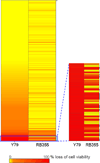Revisiting old drugs as novel agents for retinoblastoma: in vitro and in vivo antitumor activity of cardenolides
- PMID: 19151399
- PMCID: PMC3617409
- DOI: 10.1167/iovs.08-3158
Revisiting old drugs as novel agents for retinoblastoma: in vitro and in vivo antitumor activity of cardenolides
Abstract
Purpose: Intra-arterial delivery of chemotherapeutic agents offers a new and exciting opportunity for the treatment of advanced intraocular retinoblastoma. It allows local delivery of relatively high doses of chemotherapy agents while bypassing general blood circulation. For this reason, this study was undertaken to revisit some of the FDA-approved drugs for the treatment of retinoblastoma.
Methods: High-throughput screening (HTS) of 2640 approved drugs and bioactive compounds resulted in the identification of cytotoxic agents with potent activity toward both the Y79 and RB355 human retinoblastoma cell lines. Subsequent profiling of the drug candidates was performed in a panel of ocular cancer cell lines. Induction of apoptosis in Y79 cells was assessed by immunofluorescence detection of activated caspase-3. Therapeutic effect was evaluated in a xenograft model of retinoblastoma.
Results: Several FDA-approved drugs were identified that showed potent cytotoxic activity toward retinoblastoma cell lines in vitro. Among them were several cardiac glycosides, a class of cardenolides historically associated with the prevention and treatment of congestive heart failure. Caspase-3 activation studies provided an insight into the mechanism of action of cardenolides in retinoblastoma cells. When tested in a xenograft model of retinoblastoma, the cardenolide ouabain induced complete tumor regression in the treated mice.
Conclusions: Cardenolides were identified as a new class of antitumor agents for the treatment of retinoblastoma. Members of this class of cardiotonic drugs could be repositioned for retinoblastoma if administered locally via direct intra-arterial infusion.
Figures








References
-
- Abramson DH. Retinoblastoma in the 20th century: past success and future challenges the Weisenfeld lecture. Invest Ophthalmol Vis Sci. 2005;46:2683–2691. - PubMed
-
- De Potter P. Current treatment of retinoblastoma. Curr Opin Ophthalmol. 2002;13:331–336. - PubMed
-
- Brichard B, De Bruycker JJ, De Potter P, Neven B, Vermylen C, Cornu G. Combined chemotherapy and local treatment in the management of intraocular retinoblastoma. Med Pediatr Oncol. 2002;38:411–415. - PubMed
-
- Benz MS, Scott IU, Murray TG, Kramer D, Toledano S. Complications of systemic chemotherapy as treatment of retinoblastoma. Arch Ophthalmol. 2000;118:577–578. - PubMed
-
- Beck MN, Balmer A, Dessing C, Pica A, Munier F. First-line chemotherapy with local treatment can prevent external-beam irradiation and enucleation in low-stage intraocular retinoblastoma. J Clin Oncol. 2000;18:2881–2887. - PubMed
Publication types
MeSH terms
Substances
Grants and funding
LinkOut - more resources
Full Text Sources
Research Materials

